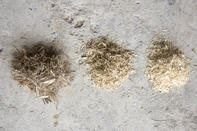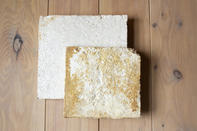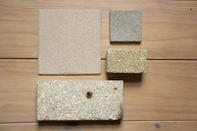Hemp, a strain of Cannabis sativa, contains low levels of the euphoric cannabinoid THC, has been used as a component in building material even during ancient times. For example, it was used by the ancient Romans to fortify the mortar in their bridges and the Chinese used a mix of chopped hemp, ground limestone, and tung oil to seal their boats.

Forms of Hemp for Building Material
Various forms of hemp (Cannabis sativa) are used in the building industry.
The inner woody core of the hemp stalk, separated from the long fibres and cut into pieces are called hemp hurd. Hurd makes up about 70% of the hemp stalk. This hemp core has a silica content of around 70% which allows it to bond well with limestone.
Hempcrete is made by combining the chopped woody inner portion of the hemp stalk and a binder consisting of natural hydraulic lime and a small amount of cement. Hempcrete is used as an insulating “in-fill” between timber structural frames for walls.
The outer fibrous skin or bast fibres of the hemp stalk is compressed into non-structural blocks, semi-rigid sheets of hemp fibre and hemp felt, all used for insulation and to build walls. These hemp sheets can be used as a direct substitute to fiberglass insulation blankets.
Hemp seeds are pressed to produce hemp seed oil, used as a wood finish, deck stain and a drying agent in paints.

Properties of Hemp for Building
Hempcrete cannot replace reinforced concrete because it has a limited load-bearing capacity. Hemp, however, has excellent thermal insulation values - well above regulation standards. Also, performs brilliantly as a lightweight “in-fill”, it is breathable and inherently airtight.
As a moisture-permeable building material, hemp can regulate internal relative humidity, preventing condensation on internal surfaces and can absorb up to 14 litres of water. Hemp is also microbe and insect resistant.
Hemp is a fast-growing crop with a low water requirement and does not require chemicals to be grown or to be processed into hurd. It is estimated that a stand of about 1 ha can yield about 8 tons of hemp hurd. This is enough to provide building material for a 50 m² dwelling.
To add to the sustainability of such an easy and fast-growing crop, hemp in the form of hempcrete is a carbon-negative material. This means it locks carbon dioxide from the atmosphere at a rate of 110 kg CO2 per m³ of hempcrete wall.
Taking into account all the positive attributes of hemp - insulation, breathability and CO2 sequestration - the cost of a hemp wall will be similar in cost to a masonry wall insulated with 60 mm extruded polystyrene.

Hemp Buildings in South Africa
A Cape Town architectural firm has been using hemp as a building material since 2008. Some of the main reasons for using hemp are the reduction of the carbon footprint of the building process, hemp’s superior insulation properties and its ease to build with. The last feature indicating that hemp construction does not require people to be skilled in building structures.
In most of the South African hemp structures (houses), hemp was used in the form of a hempcrete infill between timber structural frames. In Cape Town, a 12-storey building has been constructed (2019) with the use of hemp blocks for the internal walls. The advantages of these are lower CO2 footprint, effective sound insulation and a reduction in the weight of internal walls.
As of 2019, all hemp hurd is imported, mainly from the United Kingdom and France. Material from South African hemp trial crops have been used in the development of structural parts, but as yet (2019) there is no commercially viable crop.
“The use of hemp in the building industry has great potential for job creation and a massive reduction of the CO2 footprint of the construction industry as a whole”, says Oliver Wolf from WolfandWolf Architects.
The industry is eagerly awaiting the South African government to allow farmers to grow industrial hemp. In the meantime, South Africans are investigating viable sources of hemp from the neighbouring South African Development Community (SADC) countries who have already realised the great potential of hemp to their economies.
By Marinda Louw